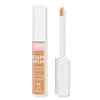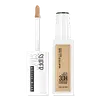What's inside
What's inside
 Key Ingredients
Key Ingredients

No key ingredients
 Benefits
Benefits

 Concerns
Concerns

 Ingredients Side-by-side
Ingredients Side-by-side

Water
Skin ConditioningDimethicone
EmollientIsododecane
EmollientAlcohol Denat.
AntimicrobialTrimethylsiloxysilicate
EmollientButylene Glycol
HumectantPEG-10 Dimethicone
Skin ConditioningSynthetic Fluorphlogopite
Isopropyl Lauroyl Sarcosinate
Skin ConditioningDiisopropyl Sebacate
EmollientHdi/Trimethylol Hexyllactone Crosspolymer
Bis-PEG/PPG-14/14 Dimethicone
EmollientSilica
AbrasiveDisteardimonium Hectorite
StabilisingPhenoxyethanol
PreservativeMagnesium Sulfate
Disodium Stearoyl Glutamate
CleansingSilica Silylate
EmollientDipentaerythrityl Tetrahydroxystearate/Tetraisostearate
Skin ConditioningAluminum Hydroxide
EmollientTocopherol
AntioxidantGlycerin
HumectantEmpetrum Nigrum Fruit Juice
Skin ConditioningPotassium Sorbate
PreservativeCI 77491
Cosmetic ColorantCI 77492
Cosmetic ColorantCI 77499
Cosmetic ColorantCI 77891
Cosmetic ColorantCI 77007
Cosmetic ColorantCI 77288
Cosmetic ColorantCeramide AP
Skin ConditioningWater, Dimethicone, Isododecane, Alcohol Denat., Trimethylsiloxysilicate, Butylene Glycol, PEG-10 Dimethicone, Synthetic Fluorphlogopite, Isopropyl Lauroyl Sarcosinate, Diisopropyl Sebacate, Hdi/Trimethylol Hexyllactone Crosspolymer, Bis-PEG/PPG-14/14 Dimethicone, Silica, Disteardimonium Hectorite, Phenoxyethanol, Magnesium Sulfate, Disodium Stearoyl Glutamate, Silica Silylate, Dipentaerythrityl Tetrahydroxystearate/Tetraisostearate, Aluminum Hydroxide, Tocopherol, Glycerin, Empetrum Nigrum Fruit Juice, Potassium Sorbate, CI 77491, CI 77492, CI 77499, CI 77891, CI 77007, CI 77288, Ceramide AP
 Reviews
Reviews

Ingredients Explained
These ingredients are found in both products.
Ingredients higher up in an ingredient list are typically present in a larger amount.
Glycerin is already naturally found in your skin. It helps moisturize and protect your skin.
A study from 2016 found glycerin to be more effective as a humectant than AHAs and hyaluronic acid.
As a humectant, it helps the skin stay hydrated by pulling moisture to your skin. The low molecular weight of glycerin allows it to pull moisture into the deeper layers of your skin.
Hydrated skin improves your skin barrier; Your skin barrier helps protect against irritants and bacteria.
Glycerin has also been found to have antimicrobial and antiviral properties. Due to these properties, glycerin is often used in wound and burn treatments.
In cosmetics, glycerin is usually derived from plants such as soybean or palm. However, it can also be sourced from animals, such as tallow or animal fat.
This ingredient is organic, colorless, odorless, and non-toxic.
Glycerin is the name for this ingredient in American English. British English uses Glycerol/Glycerine.
Learn more about GlycerinThis silicone is an emollient. Emollients create a thin film on the skin to prevent moisture from escaping.
It is not soluble in water and helps increase water-resistance in products.
According to a manufacturer, it can blend seamlessly with silicone oils, such as Cyclopentasiloxane.
Learn more about TrimethylsiloxysilicateWater. It's the most common cosmetic ingredient of all. You'll usually see it at the top of ingredient lists, meaning that it makes up the largest part of the product.
So why is it so popular? Water most often acts as a solvent - this means that it helps dissolve other ingredients into the formulation.
You'll also recognize water as that liquid we all need to stay alive. If you see this, drink a glass of water. Stay hydrated!
Learn more about Water